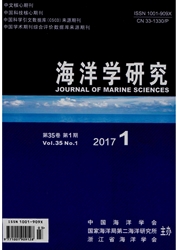

 中文摘要:
中文摘要:
2006年10月、2007年1月、4月及7月对乐清湾海域浮游动物群落的种类组成、优势种、生态类群、水平分布的季节性变化特征进行了调查,分析了浮游动物群落分布与环境因子的关系。结果表明,在调查海域共鉴定出浮游动物82种(包括浮游幼体11种),隶属于15大类,其中秋季为46种、夏季为42种、春季为25种和冬季为16种。乐清湾浮游动物可分为近岸低盐类群、暖水性近海类群、暖温带近海类群和暖水性广布类群4个生态类群,其中近岸低盐类群在全年均占优势,其它类群则呈现明显的季节变化。中华哲水蚤Calanus sinicus、真刺唇角水蚤Labidocera euchaeta、针刺拟哲水蚤Paracalanus aculeatus和背针胸刺水蚤Centropages dorsispinatus为调查海域主要优势种。浮游动物生物量年平均值为82.7mg/m3,其大小依序为:夏季(121.1mg/m3)〉秋季(119.2mg/m3)〉春季(48.5mg/m3)〉冬季(42.2mg/m3);丰度年平均值为82.1个/m3,其大小依序为:夏季(193.4个/m3)〉秋季(73.7个/m3)〉春季(53.4个/m3)〉冬季(9.8个/m3)。相同季节浮游动物生物量和丰度的平面分布趋势类似,季节间则存在明显差异。相关性分析结果表明,浮游动物物种数与水温、盐度、叶绿素a质量浓度和浮游植物细胞密度均呈极显著相关;丰度与水温、叶绿素a质量浓度和浮游植物细胞密度呈极显著相关;生物量与水温、叶绿素a质量浓度呈极显著相关。与历史资料相比,近30a来浮游动物数量呈下降趋势,但群落结构和组成没有发生明显改变。
 英文摘要:
英文摘要:
The community composition,dominant species,ecological groups and plane distribution of zooplankton in Yueqing Bay were investigated in October 2006,January,April and July 2007 at 18 stations and the relationships between the community distribution and environmental factors were analyzed.Totally 82 species of 15 major categories have been identified,including 25 species in spring,42 in summer,46 in autumn and 16 in winter,which can be divided into 4 ecological groups of coastal low salinity species,estuarine brackish water species,coastal warm water species and warm water eurytopic species.The coastal low salinity species is always dominant throughout the year,while the others have distinct seasonal variations.The main dominant species in the study area are Calanus sinicus,Labidorcera euchaeta,Paracalanus aculeatus and Centropages dorsispinatus.The annual average biomass of zooplankton is 82.7 mg/m3,and summer has the largest value(121.1 mg/m3),next is autumn(119.2 mg/m3),spring(48.5 mg/m3) and winter(42.2 mg/m3).The annual average abundance is 82.1 ind/m3,with summer(193.4 ind/m3)being the highest,followed by autumn(73.7 ind/m3),spring(53.4 ind/m3)and winter(9.8 ind/m3).The patterns of horizontal distribution of biomass and abundance are similar in same season and have distinct differences in different seasons.Studies show that the species number of zooplankton relates closely to water temperature,salinity,mass concentration of chlorophyll a and phytoplankton cell density,abundance relates to water temperature,mass concentration of chlorophyll a and phytoplankton cell density,while biomass primarily to water temperature and mass concentration of chlorophyll a.Compared with the historical data,there are no considerable changes for dominant species and ecological groups in Yueqing Bay since 1980s,but the zooplankton biomass and abundance has sharply reduced.
 同期刊论文项目
同期刊论文项目
 同项目期刊论文
同项目期刊论文
 期刊信息
期刊信息
